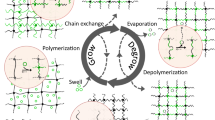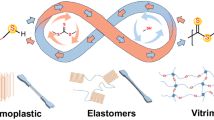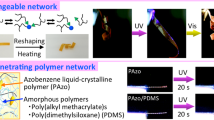Abstract
The “solid-liquid” behavior of vitrimers have not been systematically investigated. Herein, a series of “solid-liquid” vitrimers bearing varying contents of dynamic boronic ester bonds were synthesized via thiol-ene click reactions. These vitrimers allow for flexibile modulation of their network structures and thus show a range of intriguing properties including high stretchability, flexible transition from elasticity to plasticity, strong strain rate dependence, and solid-liquid performance. The dynamic association rate of boronic ester bonds within these vitrimers could be apparently accelerated via increasing the content of boronic ester, which could be used to shape-program the flat vitrimer films into various complex 3D structures just with external force. Materials with such versatile dynamic behavior may open up a range of new applications.
Similar content being viewed by others
References
Tee, B. C.; Wang, C.; Allen, R.; Bao, Z. An electrically and mechanically self-healing composite with pressure- and flexion-sensitive properties for electronic skin applications. Nat. Nanotechnol. 2012, 7, 825–832.
Wu, T.; Chen, B. Synthesis of multiwalled carbon nanotube-reinforced polyborosiloxane nanocomposites with mechanically adaptive and self-healing capabilities for flexible conductors. ACS Appl. Mater. Interfaces 2016, 8, 24071–24078.
Yuan, F.; Wang, S.; Zhang, S.; Wang, Y.; Xuan, S.; Gong, X. A flexible viscoelastic coupling cable with self-adapted electrical properties and anti-impact performance toward shapeable electronic devices. J. Mater. Chem. C 2019, 7, 8412–8422.
Boland, C. S.; Khan, U.; Ryan, G.; Barwich, S.; Charifou, R.; Harvey, A.; Backes, C.; Li, Z.; Ferreira, M. S.; Möbius, M. E.; Young, R. J.; Colema, J. N. Sensitive electromechanical sensors using viscoelastic graphene-polymer nanocomposites. Science 2016, 354, 1257–1260.
Liu, K.; Pei, A.; Lee, H. R.; Kong, B.; Liu, N.; Lin, D.; Liu, Y.; Liu, C.; Hsu, P. C.; Bao, Z.; Cui, Y. Lithium metal anodes with an adaptive “solid-liquid” interfacial protective layer. J. Am. Chem. Soc. 2017, 139, 4815–4820.
D’Elia, E.; Barg, S.; Ni, N.; Rocha, V. G.; Saiz, E. Self-healing graphene-based composites with sensing capabilities. Adv. Mater. 2015, 27, 4788–4794.
Wu, Q.; Xiong, H.; Peng, Y.; Yang, Y.; Kang, J.; Huang, G.; Ren, X.; Wu, J. Highly stretchable and self-healing “solid-liquid” elastomer with strain-rate sensing capability. ACS Appl. Mater. Interfaces 2019, 11, 19534–19540.
Wu, T.; Gray, E.; Chen, B. A self-healing, adaptive and conductive polymer composite ink for 3D printing of gas sensors. J. Mater. Chem. C 2018, 6, 6200–6207.
Zhou, X.; Zhang, X.; Zhao, H.; Krishnan, B. P.; Cui, J. Self-healable and recyclable tactile force sensors with post-tunable sensitivity. Adv. Funct. Mater. 2020, 30, 2003533.
Liu, Z.; Picken, S. J.; Besseling, N. A. M. Polyborosiloxanes (PBSs), synthetic kinetics, and characterization. Macromolecules 2014, 4, 4531–4537.
Tang, M.; Wang, W.; Xu, D.; Wang, Z. Synthesis of structure-controlled polyborosiloxanes and investigation on their viscoelastic response to molecular mass of polydimethylsiloxane triggered by both chemical and physical interactions. Ind. Eng. Chem. Res. 2016, 55, 12582–12589.
Qu, P.; Lv, C.; Qi, Y.; Bai, L.; Zheng, J. A highly stretchable, self-healing elastomer with rate sensing capability based on a dynamic dual network. ACS Appl. Mater. Interfaces 2021, 13, 9043–9052.
Zhang, G.; Zhao, Q.; Zou, W.; Luo, Y.; Xie, T. Unusual aspects of supramolecular networks: plasticity to elasticity, ultrasoft shape memory, and dynamic mechanical properties. Adv. Funct. Mater. 2016, 26, 931–937.
Zhang, H.; Wu, Y.; Yang, J.; Wang, D.; Yu, P.; Lai, C. T.; Shi, A. C.; Wang, J.; Cui, S.; Xiang, J.; Zhao, N.; Xu, J. Superstretchable dynamic polymer networks. Adv. Mater. 2019, 31, 1904029.
Denissen, W.; Winne, J. M.; Du Prez, F. E. Vitrimers: permanent organic networks with glass-like fluidity. Chem. Sci. 2016, 7, 30–38.
Zou, W.; Dong, J.; Luo, Y.; Zhao, Q.; Xie, T. Dynamic covalent polymer networks: from old chemistry to modern day innovations. Adv. Mater. 2017, 29, 1606100.
Scheutz, G. M.; Lessard, J. J.; Sims, M. B.; Sumerlin, B. S. Adaptable crosslinks in polymeric materials: resolving the intersection of thermoplastics and thermosets. J. Am. Chem. Soc. 2019, 141, 16181–16196.
Podgorski, M.; Fairbanks, B. D.; Kirkpatrick, B. E.; McBride, M.; Martinez, A.; Dobson, A.; Bongiardina, N. J.; Bowman, C. N. Toward stimuli-responsive dynamic thermosets through continuous development and improvements in covalent adaptable networks (CANs). Adv. Mater. 2020, 32, 1906876.
Montarnal, D.; Capelot, M.; Tournilhac, F.; Leibler, L. Silica-like malleable materials from permanent organic networks. Science 2011, 334, 965–968.
Pei, Z.; Yang, Y.; Chen, Q.; Terentjev, E. M.; Wei, Y.; Ji, Y. Mouldable liquid-crystalline elastomer actuators with exchangeable covalent bonds. Nat. Mater. 2014, 13, 36–41.
Yang, Y.; Pei, Z.; Li, Z.; Wei, Y.; Ji, Y. Making and remaking dynamic 3D structures by shining light on flat liquid crystalline vitrimer films without a mold. J. Am. Chem. Soc. 2016, 138, 2118–2121.
Lyon, G. B.; Cox, L. M.; Goodrich, J. T.; Baranek, A. D.; Ding, Y.; Bowman, C. N. Remoldable thiol-ene vitrimers for photopatterning and nanoimprint lithography. Macromolecules 2016, 49, 8905–8913.
Wang, S.; Yang, L.; Wang, H.; Xue, L.; Chen, J.; Cui, J. Nonequilibrium transesterification for programming a material’s stiffening. ACS Appl. Polym. Mater. 2019, 1, 3227–3232.
Lu, Y. X.; Tournilhac, F.; Leibler, L.; Guan, Z. Making insoluble polymer networks malleable via olefin metathesis. J. Am. Chem. Soc. 2012, 134, 8424–8427.
Zheng, P.; McCarthy, T. J. A surprise from 1954: siloxane equilibration is a simple, robust, and obvious polymer self-healing mechanism. J. Am. Chem. Soc. 2012, 134, 2024–2027.
Tretbar, C. A.; Neal, J. A.; Guan, Z. Direct silyl ether metathesis for vitrimers with exceptional thermal stability. J. Am. Chem. Soc. 2019, 141, 16595–16599.
Denissen, W.; Rivero, G.; Nicolaÿ, R.; Leibler, L.; Winne, J. M.; Du Prez, F. E. Vinylogous urethane vitrimers. Adv. Funct. Mater. 2015, 25, 2451–2457.
Röttger, M.; Domenech, T.; van der Weegen, R.; Breuillac, A.; Nicolaÿ, R.; Leibler, L. High-performance vitrimers from commodity thermoplastics through dioxaborolane metathesis. Science 2017, 356, 62–65.
Ogden, W. A.; Guan, Z. Recyclable, strong, and highly malleable thermosets based on boroxine networks. J. Am. Chem. Soc. 2018, 140, 6217–6220.
Bao, C.; Jiang, Y. J.; Zhang, H.; Lu, X.; Sun, J. Room-temperature self-healing and recyclable tough polymer composites using nitrogen-coordinated boroxines. Adv. Funct. Mater. 2018, 28, 1800560.
Taynton, P.; Yu, K.; Shoemaker, R. K.; Jin, Y.; Qi, H. J.; Zhang, W. Heat- or water-driven malleability in a highly recyclable covalent network polymer. Adv. Mater. 2014, 26, 3938–3942.
Chen, Y.; Tang, Z.; Zhang, X.; Liu, Y.; Wu, S.; Guo, B. Covalently cross-linked elastomers with self-healing and malleable abilities enabled by boronic ester bonds. ACS Appl. Mater. Interfaces 2018, 10, 24224–24231.
Meng, F.; Saed, M. O.; Terentjev, E. M. Elasticity and relaxation in full and partial vitrimer networks. Macromolecules 2019, 52, 7423–7429.
Saed, M. O.; Gablier, A.; Terentejv, E. M. Liquid crystalline vitrimers with full or partial boronic-ester bond exchange. Adv. Funct. Mater. 2019, 31, 1906458.
Song, K.; Ye, W.; Gao, X.; Fang, H.; Zhang, Y.; Zhang, Q.; Li, X.; Yang, S.; Wei, H.; Ding, Y. Synergy between dynamic covalent boronic ester and boron-nitrogen coordination: strategy for self-healing polyurethane elastomers at room temperature with unprecedented mechanical properties. Mater. Horiz. 2021, 8, 216–223. https://doi.org/10.1007/s10118-021-2592-1
Acknowledgments
This work was financially supported by the National Natural Science Foundation of China (No. 51973023) and Sichuan Science and Technology Program (No. 2021JDRC0014).
Author information
Authors and Affiliations
Corresponding author
Electronic Supplementary Information
Rights and permissions
About this article
Cite this article
Wang, S., Xue, LL., Zhou, XZ. et al. “Solid-Liquid” Vitrimers Based on Dynamic Boronic Ester Networks. Chin J Polym Sci 39, 1292–1298 (2021). https://doi.org/10.1007/s10118-021-2592-1
Received:
Accepted:
Published:
Issue Date:
DOI: https://doi.org/10.1007/s10118-021-2592-1




